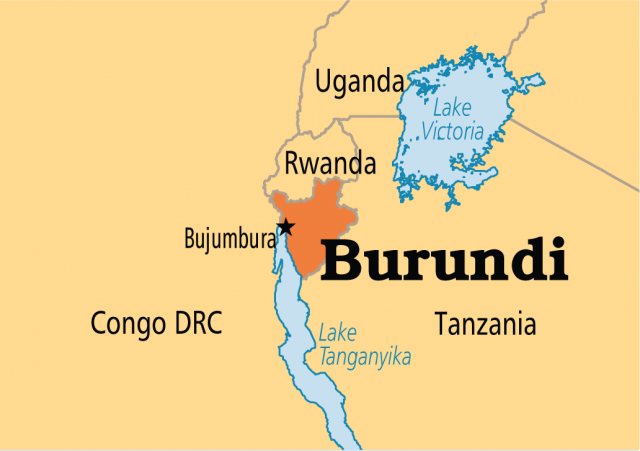Burundi
Area 10,759 square mi (27,830 square km)
Population 10.48 million 2014
Capital Bujumbura
Highest Point 8,760 ft (2,670 m)
Lowest Point 2,539 ft (772 m)
GDP $3.094 billion 2014
Primary Natural Resources coffee, tea, cotton, minerals.
BURUNDI IS A landlocked country in eastern Africa. It has borders with the Democratic Republic of the CONGO, RWANDA, and TANZANIA. Burundi is slightly smaller than the state of MARYLAND, and the economy is mostly agricultural. The 1990s represented a tragic time for Burundians. Ethnic genocide in Burundi and neighboring Rwanda contributed to a loss of over 1 million people and displacement of thousands because of an intractable war between the Tutsis and Hutus. Some scholars have speculated that tensions between the Tutsis and Hutus began during the colonial era, especially when the Tutsis were granted power and privilege positions over other ethnic groups. Further escalating the tensions was an institutionalized colonial racial policy that denigrated the Hutus and Twas. Colonialism was essentially a system of political, economic, and cultural domination forcibly imposed by a foreign minority on an indigenous majority.
The country consists of three major ethnic groups: Hutus (85 percent), Tutsis (14 percent), and Twas (1 percent). While Hutus represent the largest ethnic group, Tutsis represent an aristocratic class with lots of economic and political influence in the country. In fact, for many years, Hutus served as servants of local Tutsi aristocrats. Until 1966, the leader of the Tutsi aristocratic class was the mwami, or king. The process of colonialism began when the Burundi kingdom was incorporated into German East Africa in the 1800s. The Germans, and later Belgians, took over the kingdom and established a policy that cemented Burundi's traditional rigid social hierarchy among the Tutsis, Hutus, and Twas.

In the 1950s, Prince Louis Rwagazore, a Tutsi, formed a movement known as UPRONA, with the sole purpose of improving the Tutsi-Hutu relationship. Unfortunately, Rwagazore's untimely assassination ended any peace gesture between Tutsis and Hutus. Despite the setback, UPRONA led the country to independence in 1962. King Mwambutsa IV became the first head of state after independence. Under Mwambutsa's administration, efforts to maintain harmony between Tutsis and Hutus failed in 1965.
First, Hutus soldiers staged a military coup and succeeded in forcing Mwambutsa to go into exile. Second, Tutsi soldiers mounted a counterattack and ended the power grabbed by the Hutus. In the aftermath of the successful counterattack, revenge killings engulfed the country and continued for many years.
In 1993, Burundi's Hutu president was assassinated after only four months in office, thus leading to widespread ethnic violence all over again. An estimated 200,000 Hutus were killed in this round of ethnic strife. The killings and reprisals have created an atmosphere of political instability and uprooted Hutus, many of whom have become refugees in neighboring countries.
Burundi's future looks bleak because of continued ethnic violence and political instability. Despite its rich mineral resource base and generous foreign aid, Burundi is regarded as a very poor country. Additionally, rapid population growth and inadequate agricultural land are hampering efforts to formulate development strategies. In 2002, the Burundi government, dominated by Tutsis, signed a cease-fire agreement with three Hutu groups to end the violence. However, implementation of the agreement is proving to be very difficult, hence delaying any hope for a peaceful end to the conflict.